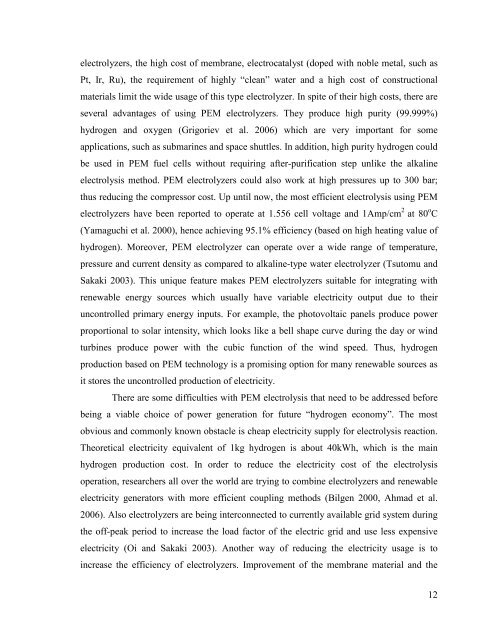hydrogen production from water using solar cells powered nafion ...
hydrogen production from water using solar cells powered nafion ...
hydrogen production from water using solar cells powered nafion ...
Create successful ePaper yourself
Turn your PDF publications into a flip-book with our unique Google optimized e-Paper software.
electrolyzers, the high cost of membrane, electrocatalyst (doped with noble metal, such as<br />
Pt, Ir, Ru), the requirement of highly “clean” <strong>water</strong> and a high cost of constructional<br />
materials limit the wide usage of this type electrolyzer. In spite of their high costs, there are<br />
several advantages of <strong>using</strong> PEM electrolyzers. They produce high purity (99.999%)<br />
<strong>hydrogen</strong> and oxygen (Grigoriev et al. 2006) which are very important for some<br />
applications, such as submarines and space shuttles. In addition, high purity <strong>hydrogen</strong> could<br />
be used in PEM fuel <strong>cells</strong> without requiring after-purification step unlike the alkaline<br />
electrolysis method. PEM electrolyzers could also work at high pressures up to 300 bar;<br />
thus reducing the compressor cost. Up until now, the most efficient electrolysis <strong>using</strong> PEM<br />
electrolyzers have been reported to operate at 1.556 cell voltage and 1Amp/cm 2 at 80 o C<br />
(Yamaguchi et al. 2000), hence achieving 95.1% efficiency (based on high heating value of<br />
<strong>hydrogen</strong>). Moreover, PEM electrolyzer can operate over a wide range of temperature,<br />
pressure and current density as compared to alkaline-type <strong>water</strong> electrolyzer (Tsutomu and<br />
Sakaki 2003). This unique feature makes PEM electrolyzers suitable for integrating with<br />
renewable energy sources which usually have variable electricity output due to their<br />
uncontrolled primary energy inputs. For example, the photovoltaic panels produce power<br />
proportional to <strong>solar</strong> intensity, which looks like a bell shape curve during the day or wind<br />
turbines produce power with the cubic function of the wind speed. Thus, <strong>hydrogen</strong><br />
<strong>production</strong> based on PEM technology is a promising option for many renewable sources as<br />
it stores the uncontrolled <strong>production</strong> of electricity.<br />
There are some difficulties with PEM electrolysis that need to be addressed before<br />
being a viable choice of power generation for future “<strong>hydrogen</strong> economy”. The most<br />
obvious and commonly known obstacle is cheap electricity supply for electrolysis reaction.<br />
Theoretical electricity equivalent of 1kg <strong>hydrogen</strong> is about 40kWh, which is the main<br />
<strong>hydrogen</strong> <strong>production</strong> cost. In order to reduce the electricity cost of the electrolysis<br />
operation, researchers all over the world are trying to combine electrolyzers and renewable<br />
electricity generators with more efficient coupling methods (Bilgen 2000, Ahmad et al.<br />
2006). Also electrolyzers are being interconnected to currently available grid system during<br />
the off-peak period to increase the load factor of the electric grid and use less expensive<br />
electricity (Oi and Sakaki 2003). Another way of reducing the electricity usage is to<br />
increase the efficiency of electrolyzers. Improvement of the membrane material and the<br />
12

















